A Bee in the Bonnet
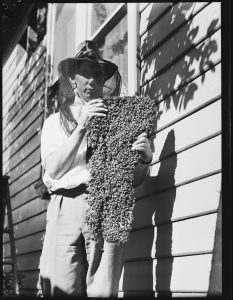
Mr F. Evans, Homebush, 15 November 1937. Courtesy State Library of NSW
Sometimes one photo, with very few details, can reveal a much bigger story – with the help of some detective work.
In November 1937, beekeeper F. Evans was summoned to a house in The Crescent, Homebush to deal with a problem – 30,000 bees that had made their home in an air vent of the home at number 27 (now the site of an apartment block at 36-37 The Crescent) for 15 months. The occasion was apparently worthy of media attention as a photographer from The Sun newspaper was there to capture the action. These photos are now in the collection of the State Library of NSW, although they are labelled only ‘Bees at Homebush, 15 November 1937.’ A search through digitised newspapers at Trove (https://trove.nla.gov.au) and Ancestry Library Edition is required to locate further details.
The home was occupied by the Robertson family – John Rae, his wife, Vera Marie and their son, Rae. According to electoral rolls, John was a ‘topman’ – a sawyer who operated from the ‘top’ of the sawpit. The home was owned by the estate of the late Ruth Rebecca Howes (sometimes Rebecca Ruth Howes) who had died in 1931. She was the widow of not one, but two publicans of the General Bourke Hotel at Parramatta – James William Carr and Thomas Sydney Howes. Ruth Howes had also held the license of the General Bourke herself.[1]
Interestingly, valuation records record that the bee-infested house in The Crescent was named Fairley or Fair Lea, although electoral rolls show that the Robertsons called their home Kopyge. This may have been a misspelling of Kopje, which means ‘small hill’. The term became familiar during the Boer War after a famous engagement at Spion Kopje. Perhaps a member of the Robertson family had served during that war. By the late 1940s John and Vera Robertson had moved from The Crescent to 48 (formerly 29) Ismay Avenue, Homebush. Jean died on New Year’s Eve 1954 and John later moved to Long Jetty, on the Central Coast, where he died in 1967.
With a little more sleuthing, the hero of the bee swarm hour has been identified as 23-year-old Frank Darcy Evans of Dundas. Evans’ skills extended way beyond bee swarms to include the new career of chick sexing, perfected in Japan. Just two years earlier he had gained the first special certificate from the Department of Agriculture for sexing 300 White Leghorn chicks in less than 28 minutes – with an accuracy rate of 98.66%.[2] And in July 1937, only a few months before rescuing the bee swarm in Homebush, he improved his performance by sexing 300 chicks in 19 ½ minutes with 99.6% accuracy.[3] This was thought to have been a world record![4] Between June and September 1936 Frank sexed 440,000 chicks, surpassing even his teacher, Mr Yogo of Japan, considered the world’s best chick-sexer.[5] Frank Evans went on to teach his skills to other students and died in 2011, aged 97.
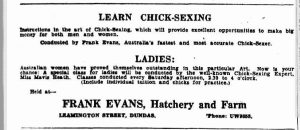
The Daily Telegraph 26 March 1938 p.17 https://trove.nla.gov.au/newspaper/article/247467993
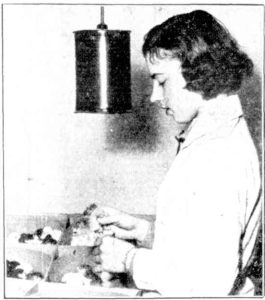
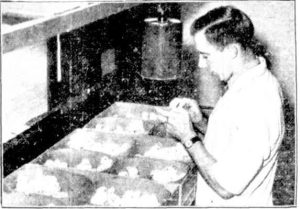
Mavis Heath and Frank Evans
The Newcastle Sun 3 July 1936 p.10 https://trove.nla.gov.au/newspaper/article/166578229
The first female chick sexer in Australia was Mary Mavis Heath,[6] who married Frank Evans in 1938. Mavis was employed by Mr S.B. Gamble’s hatchery at 472 Parramatta Road, Strathfield.[7] By 1940, Gamble Hatchery was the largest hatchery business in the Southern Hemisphere, where Stanley Benjamin Gamble also manufactured his own incubators.[8]
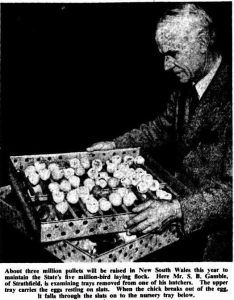
The Sydney Morning Herald 5 June 1953 p.9. https://trove.nla.gov.au/newspaper/article/18370628
To learn more about searching Ancestry Library Edition for family history, join our workshop at Strathfield Council Library and Innovation Hub on Tuesday 15 November from 1.00-3.00pm. Bookings essential at: https://www.eventbrite.com.au/e/ancestry-workshop-tickets-434739596837?aff=ebdssbdestsearch
By J.J. MacRitchie
Local Studies Advisor
References
[1] The Cumberland Argus and Fruitgrowers Advocate 5 July 1902 p.6 https://trove.nla.gov.au/newspaper/article/86204500[2] The Cumberland Argus and Fruitgrowers Advocate 10 October 1935 p.21 https://trove.nla.gov.au/newspaper/article/105097881
[3] The Cumberland Argus and Fruitgrowers Advocate 22 July 1937 p.14 https://trove.nla.gov.au/newspaper/article/106152117
[4] The Land 23 July 1937 p.7 https://trove.nla.gov.au/newspaper/article/104179232
[5] The Daily Telegraph 10 October 1936 p.7 https://trove.nla.gov.au/newspaper/article/247197476
[6] The Maitland Daily Mercury 3 July 1936 p.8 https://trove.nla.gov.au/newspaper/article/125374003
[7] The North-Western Watchman 3 September 1936 p.2 https://trove.nla.gov.au/newspaper/article/263561751
[8] The Farmer and Settler 9 May 1940 p.20 https://trove.nla.gov.au/newspaper/article/117483994

2 Comments. Leave new
Thanks for this. Frank and Mavis were my grandparents. I had heard Frank’s stories of getting bees from properties having become a keen apiarist as a teenager. He kept bees until his mid 70s and worked as a chicken sexer and owned a hatchery until retirement.
Hi Stephen. What interesting careers your grandparents had! It was a fascinating story to research. Thanks for getting in touch.